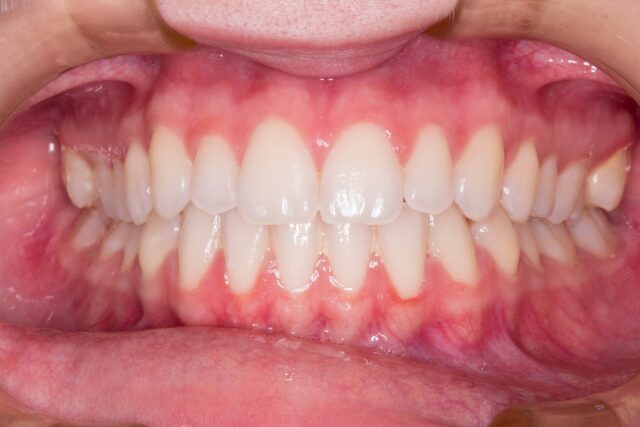1. Introduction
Small chips, cracks and discolouration are common in teeth. Habits like biting on pens, drinking coffee, or consuming sugar daily all take their toll. Many people assume that only crowns or veneers can solve these issues, but composite bonding offers a faster, more affordable, and less invasive alternative.
Bonding has grown in popularity not only for cosmetic improvements but also for its role in protecting long-term oral health. Patients can strengthen teeth, prevent decay from worsening, and improve the appearance of their smile in a single visit.
3. How Composite Bonding Developed Over Time
Dentists began using composite resins in the 1960s as alternatives to metal fillings. Early materials were limited in strength and aesthetics, often staining or wearing quickly.
Advances in nanotechnology and polymer science have transformed composites. Modern materials mimic natural enamel, resist staining, and bond securely with both enamel and dentine. This has made bonding a mainstay of both restorative and cosmetic dentistry.

5. Why Composite Bonding Matters for Oral Health
Composite bonding is not just about improving appearance. It has tangible health benefits:
- Restores strength after minor damage
- Covers exposed dentine to reduce sensitivity
- Seals surfaces against bacterial entry
- Reinforces weakened enamel
Left untreated, chips or cracks often grow worse, leading to more complex and costly procedures.
6. Benefits Beyond Health
The appeal of composite bonding also lies in its aesthetic results:
- Natural colour matching for seamless repairs
- Reshaping and balancing the smile line
- Closing small gaps without orthodontics
- Immediate results in one appointment
Patients frequently report greater confidence, which has positive effects in work, relationships, and social settings.
7. The Composite Bonding Procedure
A typical appointment involves:
- Consultation, examination and treatment planning
- Shade selection to match the surrounding teeth
- Cleaning and light etching of the surface
- Application of bonding agent and layering of resin
- Curing with a light source
- Shaping and polishing
Each tooth usually takes 30 to 60 minutes.
8. Who Is a Suitable Candidate
Bonding is ideal for patients who have:
- Minor chips or cracks
- Slight gaps between teeth
- Discolouration resistant to whitening
- Uneven edges that need reshaping
Severe decay or large structural issues often require crowns or implants.
9. Comparing Bonding with Other Treatments
- Bonding vs Veneers: Veneers involve more enamel removal and are permanent. Bonding is less invasive and reversible.
- Bonding vs Crowns: Crowns cover the whole tooth for extensive damage. Bonding focuses only on the affected area.
- Bonding vs Whitening: Whitening changes colour but not shape. Bonding can address both simultaneously.
10. Diet, Sugar and the Growing Problem of Tooth Damage
Trends in Sugar Consumption
Sugar remains a major factor in tooth decay:
- Average UK sugar consumption was 30.3 kg per person in 2021 (Helgi Library).
- Children aged 4–10 consume an average of 38.5 g/day of added sugar; adolescents aged 11–18 consume 49.9 g/day (National Diet and Nutrition Survey, via PMC).
- Tooth decay in children has declined since the UK’s sugar levy, but adults still exceed recommended limits by a wide margin (MRC Epidemiology Unit).

UK Tooth Decay and Extraction Statistics
- In 2024, 26.9% of 5-year-olds in England had enamel or dentinal decay (Gov.uk 2024 survey).
- There were 49,112 hospital extraction episodes for 0–19 year olds in 2024, with 62% caused by decay (Gov.uk, Tooth Extractions 2024).
- Costs of extractions in 2024 were estimated at £74.8 million, with £45.8 million due to decay (Gov.uk).
- Among adults, 27% of people in England have tooth decay and over half report gum bleeding (House of Commons Library).
These figures highlight why restorative treatments such as bonding are more important than ever.
11. Financial Costs of Ignoring Minor Damage
Delaying treatment raises costs significantly:
- Small fillings: £65–£150
- Crowns: £600–£1,000
- Implants: £2,500–£3,000 per tooth ([NHS and UK private averages])
Composite bonding often prevents this escalation, repairing problems early before they become severe.
12. Composite Bonding as Preventive Dentistry
Bonding functions as both a restorative and preventive treatment. It restores tooth integrity while blocking bacteria from exploiting microcracks or exposed dentine. This helps maintain oral health for longer and reduces the need for more invasive procedures.
13. Aftercare and Maintenance
Bonded teeth require the same care as natural teeth:
- Brush twice daily with fluoride toothpaste
- Floss daily or use interdental brushes
- Avoid biting hard objects
- Reduce intake of staining drinks such as red wine or coffee
- Attend regular check-ups for maintenance
With good care, bonding often outlasts its expected lifespan.
14. FAQs on Composite Bonding
Does bonding hurt?
Most patients report no discomfort.
How long does it last?
Usually 5 to 7 years, sometimes longer with care.
Can it stain?
Composite is resistant but not immune to staining.
Is it reversible?
Yes, because enamel is preserved.
15. Why Choose Droitwich Dental Studio
Droitwich Dental Studio provides composite bonding using advanced materials and digital technology to ensure precision. Patients benefit from:
- A team trained in cosmetic and restorative care
- Short-notice and same-day appointments where possible
- Transparent pricing and affordable membership options
- A calming, patient-centred environment
16. Final Word
Composite bonding is not just a cosmetic fix. It is a versatile treatment that repairs, protects, and prevents, while giving patients confidence to smile freely. In a society where sugar consumption is high and decay rates remain significant, this treatment has become more important than ever.
For patients in Worcestershire, Droitwich Dental Studio offers the expertise and care to deliver natural, lasting results.


